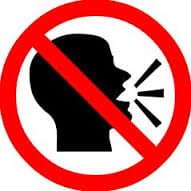
Recently I received a phone call from a fire captain in Colorado. He wanted to discuss some training ideas I inspired during my recent Training for Failure program his department hosted. One of the topics we addressed was teaching firefighters how to speak up when they have concerns. Teaching how to do this is especially important for new firefighters. Here’s why.
Recruit Firefighter Expectations
Many recruit training programs are highly regimented and recruits are taught to shut up and do as they are told. They spend weeks, sometimes months, learning how to take orders and execute those orders without question. Instructors can be intimidating – sometimes on purpose and sometimes not.
Recruits have a lot to learn and oftentimes there’s not much time for debate, discussion, or opinions about what is being taught. The programs are highly regimented and recruits are there to learn. If this describes your training program, there’s nothing wrong with that. However, environments like this teach recruits to be seen but not heard.
Post Recruit Firefighter Expectations
When recruit firefighters complete their training and receive their station assignments, it is highly probable that the respect for authority and the seen-but-not-heard expectations ingrained in them during their recruit training is likely to continue.
Most company officers and command officers I have spoken to have told me, without question, if they were making a mistake that would cause a firefighter to get hurt or killed they would want the firefighter to speak up and express their concerns in hopes of preventing a catastrophe.
 However, it’s highly likely that firefighters will not speak up – out of fear or respect.
However, it’s highly likely that firefighters will not speak up – out of fear or respect.
A few years ago I had an opportunity to give two presentations to wildland firefighters. The first day’s presentation was for the bosses. The second day’s presentation was for hand crews (frontline firefighting crews). When I was with the bosses we talked about a wildland fatality incident where front line personnel did not speak up, even though they knew things were going bad. We dissected that event and talked about organizational culture, fear of retribution and the importance of creating an environment where frontline firefighters would be willing to speak up if they thought mistakes were being made.
The bosses assured me that they have worked hard to create an open culture and strongly encourage hand crew personnel to speak up if they see or sense something is going wrong. They referred me to the wildland fire “Ten Standard Firefighting Orders” and the “Eighteen Watch Out Situations”, (a.k.a. as the “10s and 18s”). Several in attendance held up their field guides. Since they seemed to have a handle in this important cultural concept, we quickly moved on to the next lesson.
However, on the second day, when I had the hand crews in the room, the story was quite different. Along with the hand crews, there were also some crew bosses present so I asked them to step out of the room for a few minutes so I could talk just to the hand crews. Once the room was clear of all bosses, I asked the hand crews to raise their hands if they would be comfortable speaking up if they saw or sensed something was going wrong in the field. Out of 50+ in the room, three raised their hands and one of them qualified his vote by saying it depended on which crew boss it was.
Speaking up is a skill
Knowing when and how to speak up if there is a concern… is a skill. As a skill, it can be taught. But is it? The curiosity about this led me to the next question for the students. Raise your hands if you’ve ever participated in a training session where you actually practiced speaking up to a boss.
Several of the attendees had admitted to receiving instruction about how and when to speak up. But, sadly, not one student in the room had ever practiced the skill. It’s much easier to TALK ABOUT speaking up than it is to ACTUALLY speak up.
This brings me back to my discussion with the Captain that prompted this post. Like the bosses of the wildland crews he also admitted to having many discussions where he encouraged his firefighters to speak up. But, by his admission, they’d never actually practiced it.
 I recommended the captain teach his crew how to disagree with him and then have them practice the skill. It’s important that during the practice, the firefighters avoid talking in the third-person voice (e.g., “I would tell the captain that I disagree with his decision because…”). There is no ownership in the action when presented in the third-person voice. Rather, the firefighter would look the captain in the eye and say something like: “Captain Jones, I have a concern about what we are doing here and I want to tell you why before we engage. Then the firefighter would express the concern in a first-person voice, talking directly to the captain as if it were a real conversation on a real fireground.
I recommended the captain teach his crew how to disagree with him and then have them practice the skill. It’s important that during the practice, the firefighters avoid talking in the third-person voice (e.g., “I would tell the captain that I disagree with his decision because…”). There is no ownership in the action when presented in the third-person voice. Rather, the firefighter would look the captain in the eye and say something like: “Captain Jones, I have a concern about what we are doing here and I want to tell you why before we engage. Then the firefighter would express the concern in a first-person voice, talking directly to the captain as if it were a real conversation on a real fireground.
Expect there to be some stumbling and stammering at first because many firefighters are going to be uncomfortable voicing their concerns. The captain could, preemptively, demonstrate how he/she would want to be addressed under such conditions by role-playing as the firefighter. This will help the firefighters find the words – and the courage – to speak up.
Then, once the courage has been mustered in the classroom, it is time to take the skill to the next level and create training scenarios where the captain makes a bad decision and/or gives inappropriate orders on purpose. Of course, it goes without saying, these scenarios should never create actual danger for the firefighters. Then, in the moment, the firefighter practices their newly acquired skillset of speaking up.
The Five Step Assertive Statement Process
I have previously written about this concept so I will only cover it in summary fashion here and include a link to the article.
 The Five Step Assertive Statement Process comes directly from the Crew Resource Management program developed in aviation. For the process to be most effective, a department should develop a policy and train all ranks on when, why and how to use the process. The steps of the process include:
The Five Step Assertive Statement Process comes directly from the Crew Resource Management program developed in aviation. For the process to be most effective, a department should develop a policy and train all ranks on when, why and how to use the process. The steps of the process include:
1. Addressing the person you have a concern with formally.
2. Using a standard phrase to indicate you have a concern. (In aviation, it is simply “I have a concern.”)
3. State the concern.
4. Recommend an alternative action.
5. Gain approval or consensus of the decision maker.
CLICK HERE to read the article written on this topic.
Dr. Gasaway’s Advice
 It is likely that in most organizations the bosses would want subordinates to speak up if there was a concern about safety or concerns about errors in decision making. Sadly, however, in some organizations, the culture is not supportive of subordinates taking exception to the decisions of superiors. So, the subordinates say nothing and let the incident degrade into a catastrophe. This leads to outcomes that are both tragic and avoidable.
It is likely that in most organizations the bosses would want subordinates to speak up if there was a concern about safety or concerns about errors in decision making. Sadly, however, in some organizations, the culture is not supportive of subordinates taking exception to the decisions of superiors. So, the subordinates say nothing and let the incident degrade into a catastrophe. This leads to outcomes that are both tragic and avoidable.
I recommend developing a policy that stipulates the terms and conditions that authorize a subordinate to speak up and express a concern without fear of retribution. In fact, the policy should go as far as to explicitly state the employee will be protected from retribution.
But a policy is not enough. Subordinates need to practice the script, in the first-person voice, to gain comfort with how to utter the words and how to overcome the inherent fear of defying an authority figure.
Honestly, some bosses will also need to practice receiving this kind of feedback. Because, let’s face it, some bosses are equally uncomfortable receiving the feedback that indicates they may be making a mistake.
The Pigs are Eating Lemons
A couple of years ago I had the opportunity to speak to the recruit class of the Buckley Fire Department (Washington). Fire Chief Alan Predmore was in attendance and he took my message seriously. Having firefighters who would not speak up if they had a concern was, in his words, “unacceptable.” So he engaged his firefighters in a discussion about how to speak up and what they might say if they had a concern.
Step 2 of the Assertive Statement Process is to use a phrase that indicates there is a concern. In Buckley, they got creative. They wanted a phrase that would be so unusual that the commander would have to stop and listen up. They chose: “The Pigs are Eating Lemons!” It may not work for everyone… but it worked for Buckley.
Click below to listen to the SAMatters Radio show episode where I interviewed Chief Alan Predmore about this creative safety initiative.
Action Items
 1. Assess your department’s culture to determine if line personnel feel free to speak up when there are concerns for safety.
1. Assess your department’s culture to determine if line personnel feel free to speak up when there are concerns for safety.
2. Assess your department’s culture to determine if supervisors are open to critical feedback.
3. Consider developing a policy to address how and when to employ an assertive statement process.
4. Provide training for all personnel on how to give and receive critical feedback.
5. Create training scenarios where personnel practice the skill expressing concerns for safety.
About the Author
Richard B. Gasaway, PhD, CSP is widely considered a trusted authority on human factors, situational awareness and the high-risk decision making processes used in high-stress, high consequence work environments. He served 33 years on the front lines as a firefighter, EMT-Paramedic, company officer, training officer, fire chief and emergency incident commander. His doctoral research included the study of cognitive neuroscience to understand how human factors flaw situational awareness and impact high-risk decision making.
_____________________________________________________

If you are interested in taking your understanding of situational awareness and high-risk decision making to a higher level, check out the Situational Awareness Matters Online Academy.
CLICK HERE for details, enrollment options and pricing.
__________________________________
Share your comments on this article in the “Leave a Reply” box below. If you want to send me incident pictures, videos or have an idea you’d like me to research and write about, contact me. I really enjoy getting feedback and supportive messages from fellow first responders. It gives me the energy to work harder for you.
Let’s Get connected
Facebook: SAMatters
LinkedIn: Rich Gasaway
LinkedIn: Situational Awareness Matters
Twitter: Rich Gasaway
Youtube: SAMattersTV
itunes: SAMatters Radio
Stitcher Radio: SAMatters Radio
Google Play: SAMatters Radio
iHeart Radio: SAMatters Radio

Hi Rich
Interesting information, very useful and thought provoking! Yes, it seems we are at all different stages when it comes to culture, particularly when operating in dynamic situations. But we must in the interests of each and every persons health, safety and welfare address the all important subject area of communication!!! We in the UK use the Incident Command System, where we look seriously at distinct lines of communication from the front line backwards. Also the span of control and the designation of Safety Officers in sectors…but we teach that it is crucial that important information is passed on in some instances within seconds by ANYONE noticing, (signs of collapse of a building for instance) to prevent a tragic incident or catastrophe!
Good call, stay safe. Paul.
Paul,
Thank you for sharing your perspective. It makes our community of learners stronger and smarter when we share our experiences. I think you point about anyone (emphasis added) being able to point out concerns is powerful. I think a lot of fire departments here in the U.S. have figured that out and engrained that into their culture. However, sadly, there are many that have not.
Keep sharing!
Rich